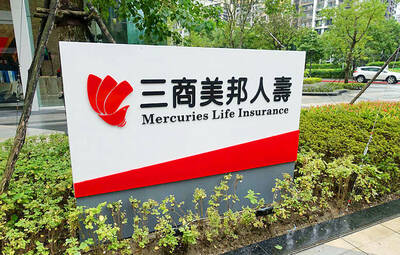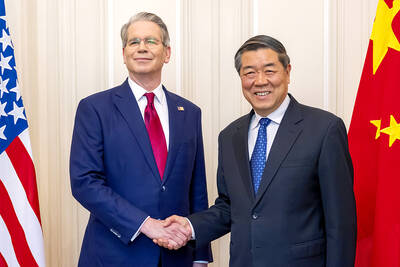Taiwan Semiconductor Manufacturing Co (TSMC, 台積電), the world’s top contract chipmaker, yesterday reported a 9.1 percent annual growth in revenue to NT$40.5 billion (US$1.38 billion) last month, an all-time high as restocking demand grew at a faster-than-expected pace.
That was up from NT$37.13 billion last year. On a monthly basis, TSMC’s revenue rose 9.2 percent from NT$37.08 billion.
“This result is in line with our expectation of NT$40.4 billion,” Credit Suisse analyst Randy Abrams said in a research note yesterday. “We expect to see continued month-on-month growth into May and June.”
Last month, TSMC forecast revenue would hit a record high this quarter, ranging between NT$126 billion and NT$128 billion, which would be between 19 percent and 21 percent higher then last quarter’s NT$105.51 billion.
Sales were driven by inventory restocking and growth in the communications sector, Abrams said.
“Orders were stronger than we had expected, which allowed us to have a solid second quarter. Forecasts of incoming orders are also very strong,” TSMC chairman Morris Chang (張忠謀) said at an investor conference on April 26 in Taipei. “This means the third quarter will be a continued-growth quarter.”
Chang said at the time that the worldwide semiconductor market would grow at a faster pace than his previous estimate of 2 percent annual growth in revenue, citing encouraging macroeconomic news from the US and China, which are the chipmaker’s biggest markets.
Excluding the memorychip business, growth would be between 3 percent and 4 percent, he added.
Separately, TSMC plans to spend more than US$1 billion on research and development this year, company spokesman Elizabeth Sun (孫又文) said on the sidelines of a TSMC technology forum in Hsinchu.
That number represents about 8 percent to 9 percent of the chipmaker’s expected total revenue this year, Sun said.
Last year, TSMC spent NT$33.68 billion on research and development, or about 7.9 percent of the company’s revenue of NT$427.08 billion, according to the company’s annual financial statement posted on its Web site.
Because of stronger demand, TSMC was unable to keep up with demand for its 28-nanometer (nm) chips for mobile devices, Chang said last month.
He expected supply constraints to improve in the fourth quarter and to be fully resolved in the first quarter of next year.
TSMC is effectively the sole foundry supplying 28nm chips, Chang said, as rivals such as United Microelectronics Co (UMC, 聯電), Globalfoundries Inc and Samsung Electronics Co have not started mass producing 28nm chips.
The chipmaker expects 28nm chips to make up 20 percent of its revenue in the fourth quarter.
Earlier this week, UMC reported its strongest monthly revenue in nine months at NT$9.12 billion for last month, beating Credit Suisse’s estimate of NT$8.44 billion.
That represented 11.4 percent monthly growth from March’s NT$8.19 billion. However, it was down 4.59 percent from the NT$9.56 billion posted in April last year.

France cannot afford to ignore the third credit-rating reduction in less than a year, French Minister of Finance Roland Lescure said. “Three agencies have downgraded us and we can’t ignore this cloud,” he told Franceinfo on Saturday, speaking just hours after S&P lowered his country’s credit rating to “A+” from “AA-” in an unscheduled move. “Fundamentally, it’s an additional cloud to a weather forecast that was already pretty gray. It’s a call for lucidity and responsibility,” he said, adding that this is “a call to be serious.” The credit assessor’s move means France has lost its double-A rating at two of the

AI BOOST: Although Taiwan’s reliance on Chinese rare earth elements is limited, it could face indirect impacts from supply issues and price volatility, an economist said DBS Bank Ltd (星展銀行) has sharply raised its forecast for Taiwan’s economic growth this year to 5.6 percent, citing stronger-than-expected exports and investment linked to artificial intelligence (AI), as it said that the current momentum could peak soon. The acceleration of the global AI race has fueled a surge in Taiwan’s AI-related capital spending and exports of information and communications technology (ICT) products, which have been key drivers of growth this year. “We have revised our GDP forecast for Taiwan upward to 5.6 percent from 4 percent, an upgrade that mainly reflects stronger-than-expected AI-related exports and investment in the third

Mercuries Life Insurance Co (三商美邦人壽) shares surged to a seven-month high this week after local media reported that E.Sun Financial Holding Co (玉山金控) had outbid CTBC Financial Holding Co (中信金控) in the financially strained insurer’s ongoing sale process. Shares of the mid-sized life insurer climbed 5.8 percent this week to NT$6.72, extending a nearly 18 percent rally over the past month, as investors bet on the likelihood of an impending takeover. The final round of bidding closed on Thursday, marking a critical step in the 32-year-old insurer’s search for a buyer after years of struggling to meet capital adequacy requirements. Local media reports

RARE EARTHS: The call between the US Treasury Secretary and his Chinese counterpart came as Washington sought to rally G7 partners in response to China’s export controls China and the US on Saturday agreed to conduct another round of trade negotiations in the coming week, as the world’s two biggest economies seek to avoid another damaging tit-for-tat tariff battle. Beijing last week announced sweeping controls on the critical rare earths industry, prompting US President Donald Trump to threaten 100 percent tariffs on imports from China in retaliation. Trump had also threatened to cancel his expected meeting with Chinese President Xi Jinping (習近平) in South Korea later this month on the sidelines of the APEC summit. In the latest indication of efforts to resolve their dispute, Chinese state media reported that